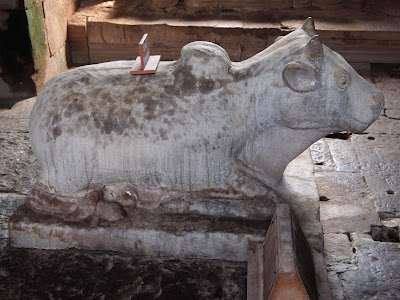Did I say the overnight train was an excellent way to
travel? I wasn’t lying. It was excellent at 5 pm, 8pm, even 1am. Around 2am, when I was still awake,
it felt a bit less excellent. Same at 4am when we were supposed to get up and get off.
Also at 6am, when, still without sleep, we finally made it to our
stop. Oy. The upside is that I had lots of time to
catch up on the posts from Isan!
So, Phnom Rung.
Prasat Phnom Rung,
a Khmer Temple in the Buriram province of Isan, was built between the 10th
and 13th centuries A.D. on top of an extinct volcano. (“Phnom Rung is from the ancient Khmer “Vnam
Rung” and means “vast mountain.”) The most famous Khmer temple is Angkor Wat in
Cambodia. But that temple, while far
better known, is a later iteration of this temple and a couple others in
Thailand.
Prasat Phnom Rung is
on the very outskirts of Thailand. How
close to the border? Well, that horizon
line is Cambodia itself, so pretty close!
Because it is so far
out, very few people visit the temple.
School children (at least those in the area) are required, however, and
we saw a few classes. Other than that,
though, there were times when we were 4 of perhaps 10 people in the temple
complex.
[An aside: as for the
school children, we, or at least the girls, were definitely more interesting to
them than the ruins. My sister and
brother had warned us that a) Thai people loved children and were very physically
affectionate with them- they would rub their cheeks, kiss them, grab their
arms, etc. and b) Western children, especially blue eyed like Tess or pale like
Kaia, were fascinating to them, even more so the further from Bangkok we
travelled. We’d seen that to be true in
Ko Pet, but these kids and their teachers brought it to a whole new level. We came upon one group that was taking a
class photo in front of the temple. Then
they noticed us. I’m not kidding when I
say they were like a swarm of bees. They
literally ran over to the girls, cooing and pointing and began blatantly
snapping pictures of them. Then one of
the teachers gestured that she wanted to take a picture with them. The same thing has happened several times
since- not just kids but adults taking pictures, pointing, wanting to touch
them, etc. The photo to the above left is of people
taking a picture with the girls. They
were just random folks at Wat Pho who saw Kai and Tess and asked to pose with
them. The girls know it is innocent, but
it has taken some getting used to!]
The Khmer who
built this temple were Hindu, and Phnom Rung was dedicated to one of the supreme
Hindu deities, Shiva. His image and symbols can be found through out
the temple ruins.
The temple and its sanctuary represent the mountain Kailasa
and Shiva’s pantheon and symbolize the center of the universe.
 |
| Homemade Viagra!! |
Shiva is, among
other things, a god of virility.
An…interesting local practice has grown up around this particular aspect
of Shiva. The stone in the photo to the left is
clearly a phallic symbol, representing Shiva.
If you look beyond it you’ll see a hole in the ground. When the temple was actively being used,
priests would pour water over the stone and then recapture the water, now
imbued with Shiva’s blessing. They would
then pour the water over the king as he stood in the hole (and the water would
then funnel to another hole for the queen, and then funnel out to the
crowd). Priests no longer pour water
over the phallus to receive Shiva’s blessing.
But apparently local boys will pee on it to the same end.
They will also pee on
this bull because of its association with Shiva. (In mythology, Shiva’s lover
was jealous that Shiva always took his wife into battle and never the lover. To
appease her jealousy, Shiva's lover was turned into a bull and ridden into battle by
Shiva and his wife.) Do I need to tell you
what it smelled like in this particular part of the ruins?
The rest of the area was just beautiful. I can’t imagine what it looked like when it was an active temple, but the ruins left even now, more than a thousand years later, exude grandeur and elegance.
 |
| Imagine this walk lit by enormous candles, as it once was. |
 |
| one of the minor temples within the complex |









No comments:
Post a Comment